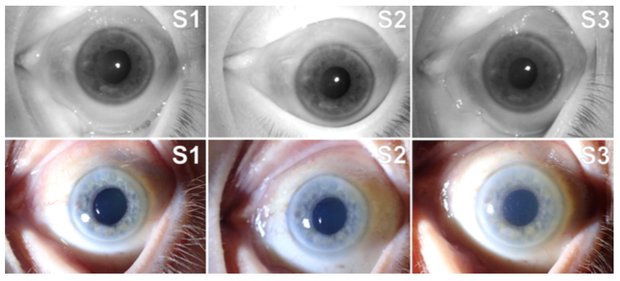Dead eye can successfully undergo iris scan

Photo death eyes after 5, 16 and 27 hours
We all watched movies where, in order to pass control, you need to confirm your identity by scanning the iris. This technology is not devoid of meaning, because the eye pattern is also unique for each person, like fingerprints, and, among other things, does not change over time. This technology is already being fully implemented at border control points and at airports, and the government of India does compile a catalog of irises of the entire population of the country, and this is not a lot of little, more than 1 billion people.
In the same films showed ways to circumvent this system. Most popular: contact lenses imitating someone else's eye pattern. But in no other movie did a person kill his eyes (although the commentary mentioned the Demolition Man tape where this method was used), although it would have seemed much more logical to bring an eye in your pocket than to make lenses. Why? It was believed that the dead man's eye changes its structure and is no longer suitable for the passage of control.
')
As it turned out, suitable.
To begin with, the "shelf life" of the eyes of the deceased is seriously limited in time - about 27 hours, but in some cases it can reach several days. This is due to the fact that after death, the cornea of a person’s eyes becomes cloudy, which makes scanning difficult. After an average of 27 hours, the eye will become so clouded that the system will not be able to identify it. In addition, the eyes of the dead are not suitable for the passage of more complex control systems.
If you do not have time to bring the eye to the scanner during the day, then even a printout of an eye on a piece of paper may be suitable to deceive a number of cheap commercial solutions.
That is why many modern iris scanning systems are equipped with a whole range of tools. For example, infrared sensors are actively used to determine whether the eye is alive or in front of the scanner is the same printout (which does not prevent us from warming the eye of the deceased in our pocket).
After discovering the fact that the eye of the deceased is quite an eye for almost a day, the author of the study began to use a more complex approach.
During the initial scanning of the iris, as conceived by the author, the scanner emits a beam of light to register the reaction of the iris and the degree of pupil constriction. These data are entered into the profile of a person and subsequently, the scanner can repeat this procedure and compare the reaction of the eye offered to it with the reaction recorded in the user profile.

Fixing the reaction of the eye to a beam of light
This allows you to solve several problems at once, such as trying to slip a print of the retina, use lenses (after all, each person has the muscles that are responsible for narrowing the pupil individually), as well as check the most eerie of possible scenarios - using the human eye posthumously.
Such a system is quite efficient in the laboratory, however, it is not known how it will show itself in real conditions, that is, with dynamic lighting. The fact that problems with field development operations may arise is recognized by the developer.
Source: https://habr.com/ru/post/396409/
All Articles